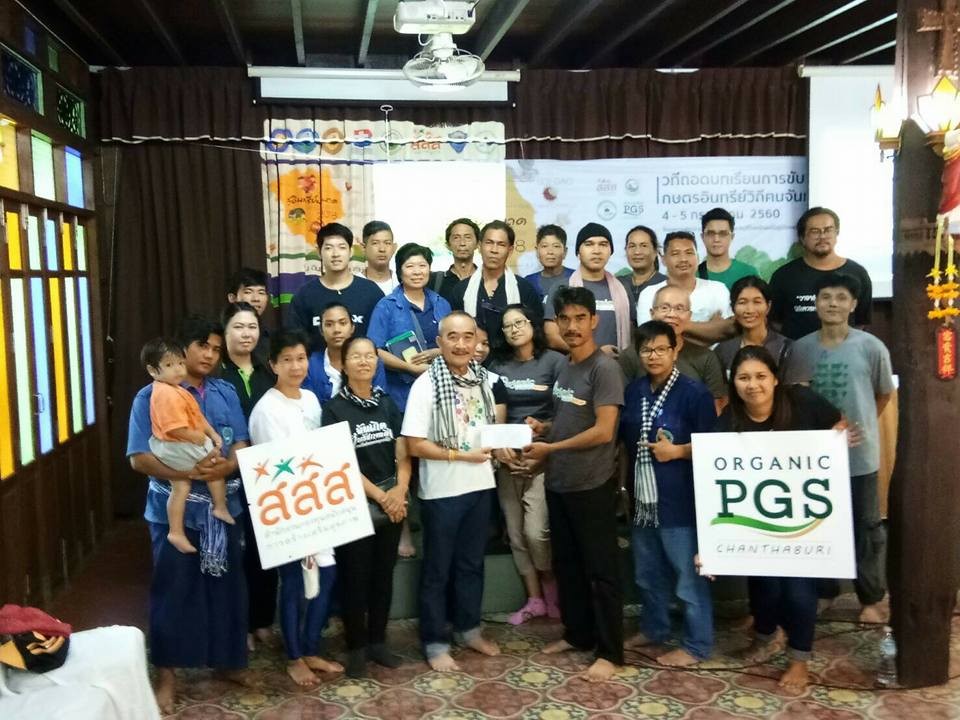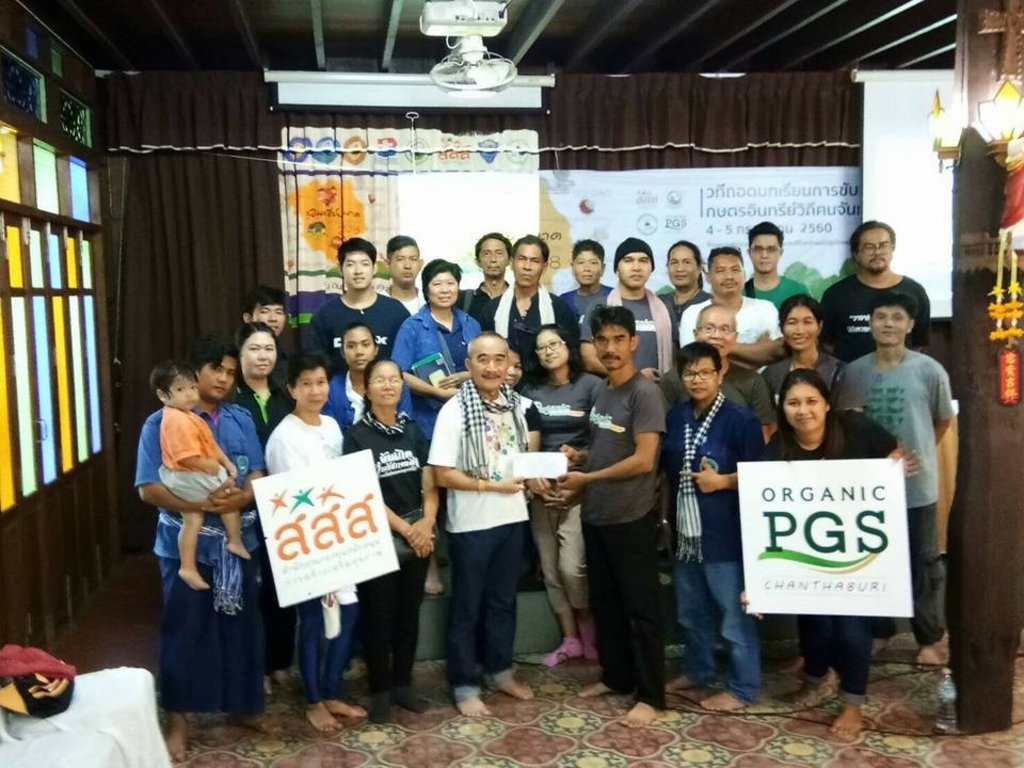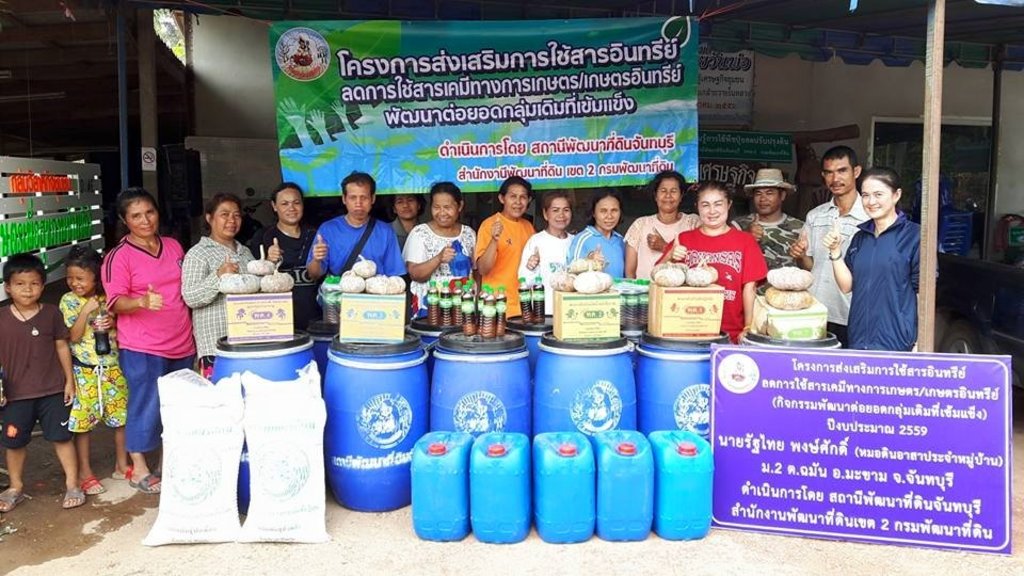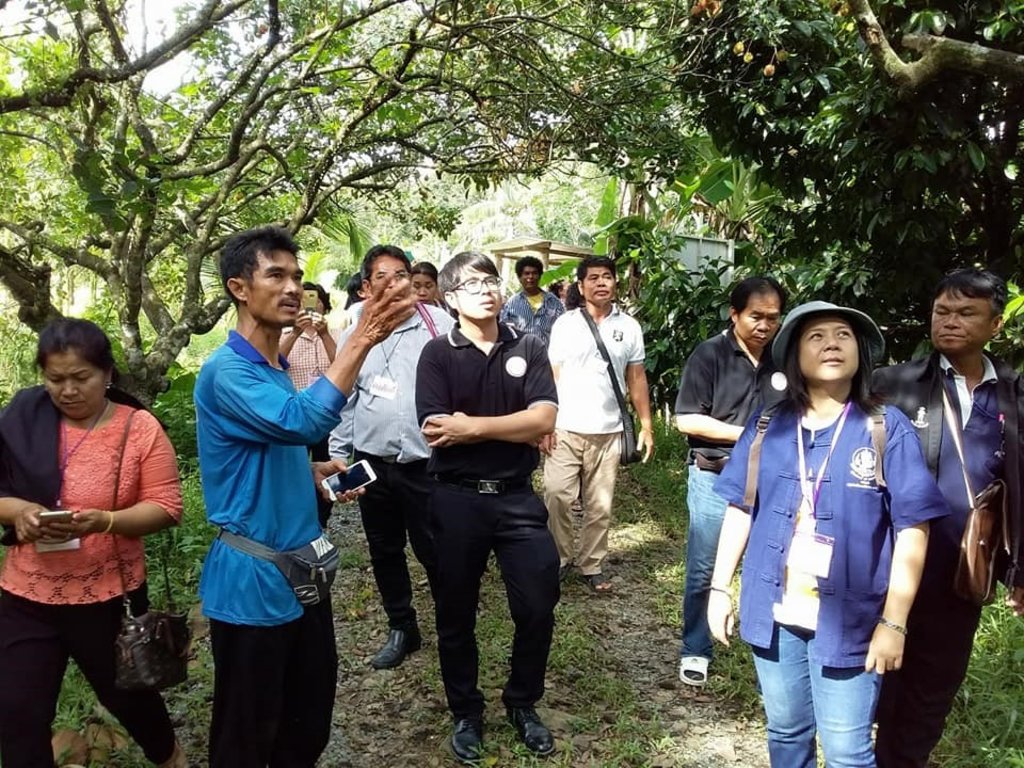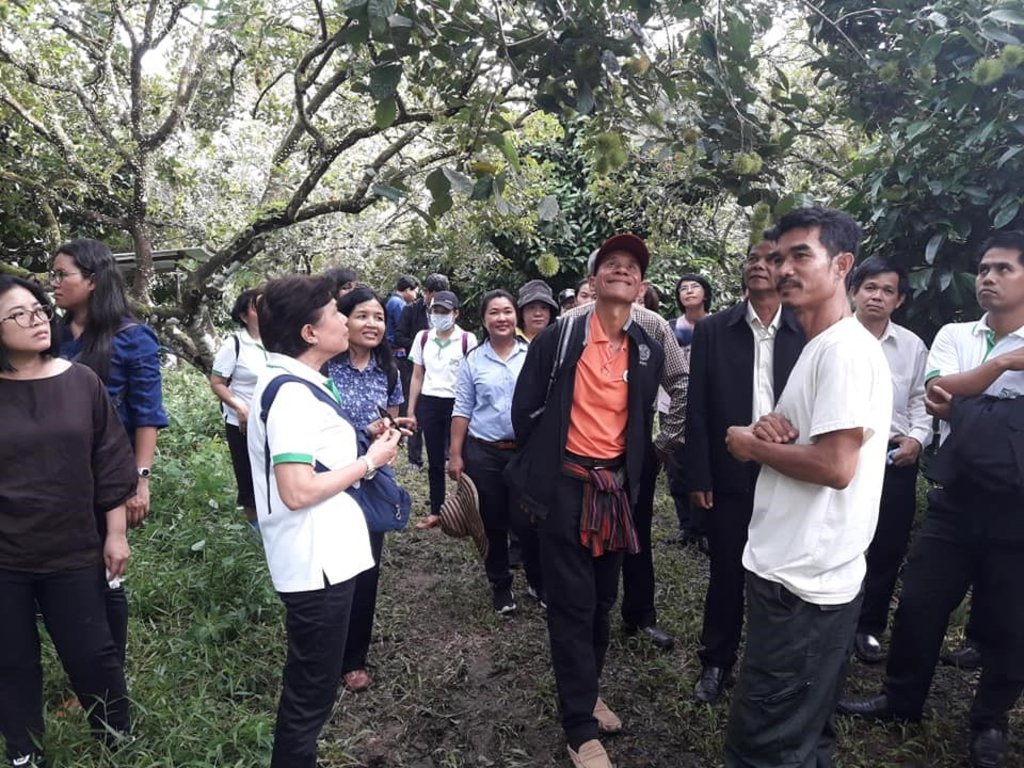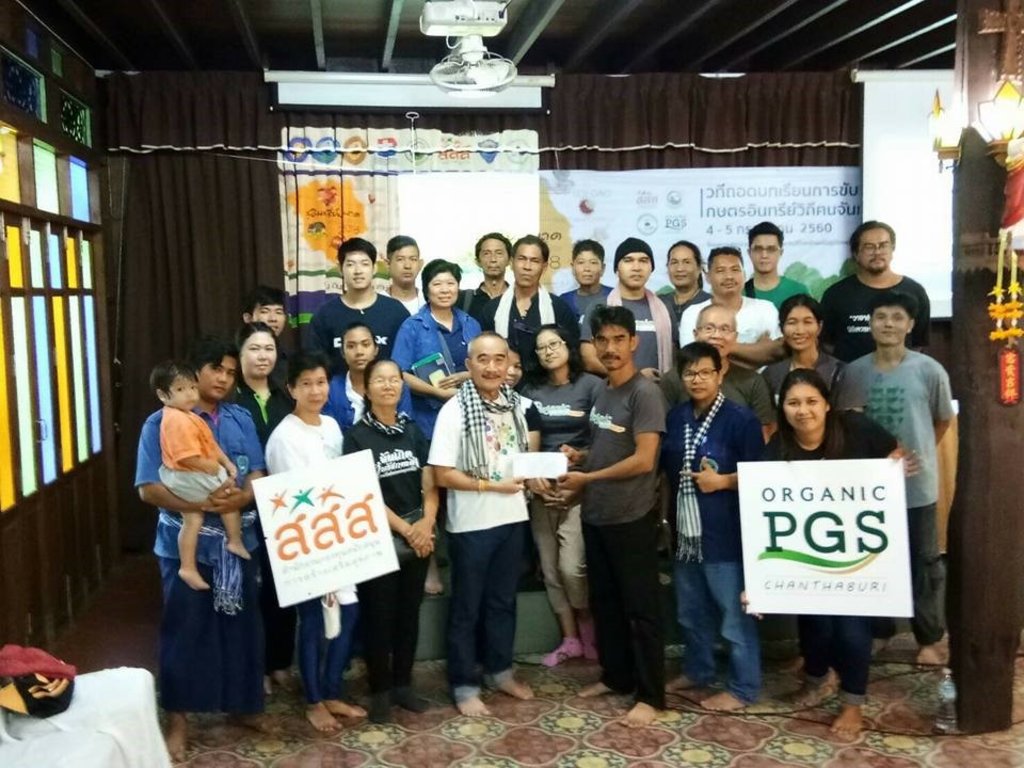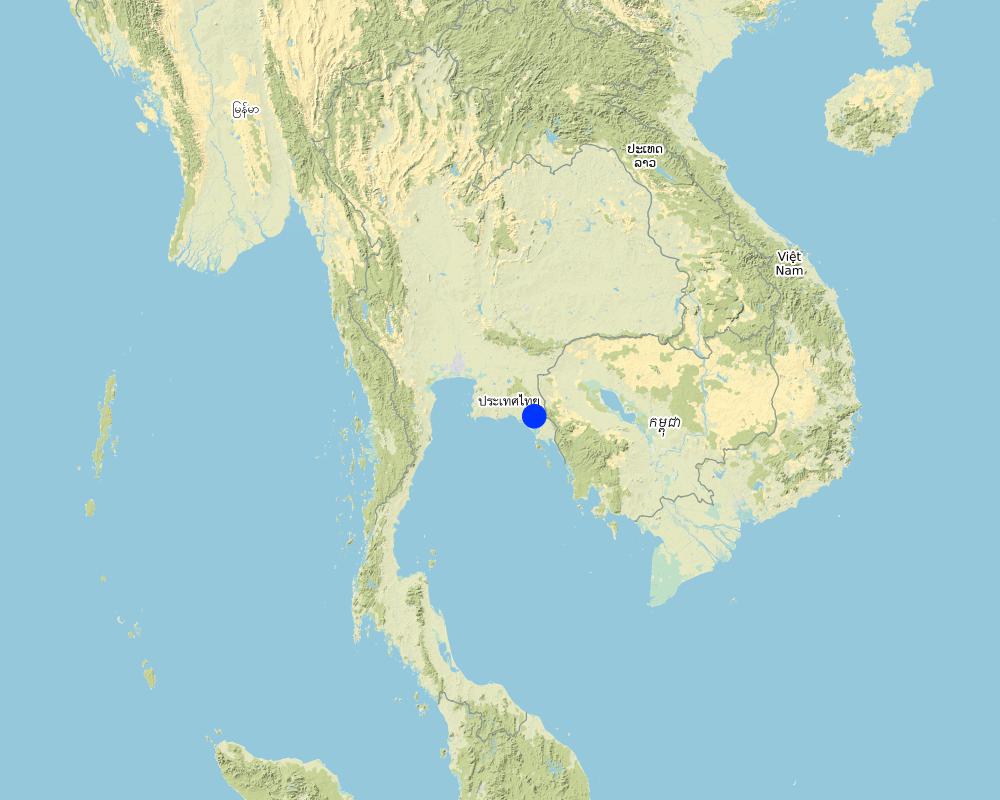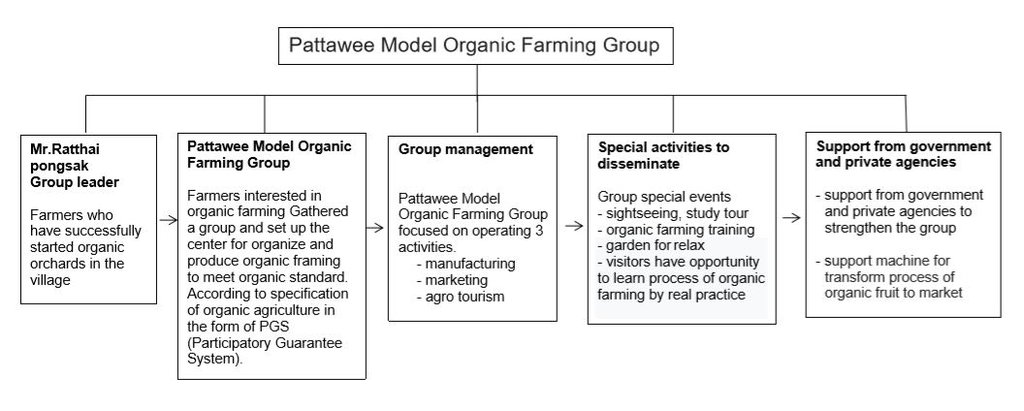Pattawee Model Organic Farming Group [Thailand]
- Creation:
- Update:
- Compiler: Kukiat SOITONG
- Editor: –
- Reviewers: Rima Mekdaschi Studer, William Critchley
Patawee model
approaches_4268 - Thailand
View sections
Expand all Collapse all1. General information
1.2 Contact details of resource persons and institutions involved in the assessment and documentation of the Approach
Key resource person(s)
co-compiler:
ผู้รวบรวม:
Phaipakwan Parichart
0-3721-0781 / 08-5920-8429
parichat19@hotmail.com
Prachinburi Provincial Land development Station
135/1Moo 5 Tambon Noenhom Muang District Prachinburi Province 25230
Thailand
suppored farm inputs ,publication public relation TV program social media:
Charoenthaweechai Chanjira
0-3943-3713-4 / 08-1845-3611
jangi@windowslive.com
Chantaburi Land Development Station
Moo. 8 Tambon Nayayarm NAyaarm District,Chathaburi province 22160
Thailand
land user:
Somphan Songwut
08-98298252 / -
- / -
farmer
42/12 Moo1 Tambon Klongpoo Kaokichakood District ,Chathaburi province
Thailand
land user:
Raksa Somporn
08-494-50626 / -
- / -
เกษตรกร
5/9 Moo2 Tambon PAtthawee MAkham District Chathaburi province
land user:
Wichiannoi Weenus
08-1868-1911 / -
- / -
เกษตรกร
7 Moo 12 Tambon Phubphla Muang District Chanthaburi province
1.3 Conditions regarding the use of data documented through WOCAT
When were the data compiled (in the field)?
23/11/2018
The compiler and key resource person(s) accept the conditions regarding the use of data documented through WOCAT:
Yes
2. Description of the SLM Approach
2.1 Short description of the Approach
The Patawee Model Organic Farming group is a learning center and network for organic fruit and vegetable production.
2.2 Detailed description of the Approach
Detailed description of the Approach:
The Pattawee Model Organic Farming Group is a learning center and network for organic fruit and vegetable production. The group's farm products are certified as organic, and qualify for the Participatory Guarantee System (PGS). They are for both domestic and export markets. The group plays a role in a knowledge exchange forum, in consultation, and in participatory problem-solving under the PGS. The PGS quality assurance system is based on the foundation of trust, social networking and information/knowledge exchange. The Pattawee Model Organic Farming Group's objectives are to bring together fruit and vegetable growers to learn, and to increase their ability to produce and market as well as to promote knowledge among the general public about organic standards for fruits and vegetables. The Pattawee Model Organic Farming Group has the following procedures: the first step is grouping the growers, then setting up a knowledge exchange forum and strengthening organic standard production management among them. Then marketing management, both domestic and international, follows. Next is promoting knowledge of production standards to the public. Also, agro-tourism helps to generate supplementary income. Public relations are through several activities: technology transfer, training, exhibition, printed media and using Facebook. Last but not least, an enterprise community has been set up.
The grouping began when Mr. Ratthai Pongsak started organic fruit farming in Pattawee Village. Many farmers and interested persons visited his farm and became interested in organic farming. These interested farmers agreed to join in a group called “The Pattawee Model Organic Farming Group”, as a center for organic farmers. The organic farming group has provided a forum for exchanging knowledge, supplying inputs, sharing, analyzing and exchanging market data. Meetings are held on a monthly basis. The group has adapted the standard of group management in accordance with the organic standards under the PGS system - according to the government’s suggestion: this covers production, marketing and agro-tourism as the three dimensions of group work. The group has organized activities to support marketing management, such as the dissemination of organic farming, the selling of the products, and an agro-tourism program that involves opening the organic farms to visitors. There is also training, publishing and promoting the works of the group. Technology transfer is through the learning center. The group has been strengthened by the government and private sectors; for example, the organic fruit processing machinery was supported by them.
The Pattawee Model Organic Farming Group has a number of key stakeholders. The chairperson plays a very important role in group management, driving the group activities and supporting technology transfer, providing a location and finance to the group. Members of the group play a role in exchanging knowledge about product management, processing, clearing, screening fruit grades, marketing, purchasing, knowledge transfer, exhibitions and sales through the online media. Interested parties include farmers, the soil volunteer doctor, students, tourists, consumers. Marketing enterprises involved include TOP Market, Lemon Farm, buyers from Japan, Korea and Europe. Both government and private agencies play an important role in supporting all aspects of the group and its activities.
2.3 Photos of the Approach
2.4 Videos of the Approach
Comments, short description:
Pattawee Community Enterprise for Health MAkham District Chanthaburi province
Date:
03/06/2018
Location:
5 Moo 2 … Sub-district, Makham District Chantaburi province, Thailand
Name of videographer:
Natural Agriculture network Phuket
Comments, short description:
Pattawee Community Promote Organic Farming
Date:
26/05/2015
Location:
5 Moo 2 … Sub-district, Makham District Chantaburi province, Thailand
Name of videographer:
NBT New
Comments, short description:
The Pattawee Community Enterprise for health in Tambon Pattawee Makham District Chantaburi province produce quality Organic Fruits and are connected to entrepreneurs and consumers as well as being open to agro-tourists.
Date:
06/06/2015
Location:
5 Moo 2 … Sub-district, Makham District Chantaburi province, Thailand
Name of videographer:
TNAMCOT
2.5 Country/ region/ locations where the Approach has been applied
Country:
Thailand
Region/ State/ Province:
Chantaburi province
Further specification of location:
5 Moo 2 Tambon Makham district Chantaburi Thailand
Comments:
-
Map
×2.6 Dates of initiation and termination of the Approach
Indicate year of initiation:
2016
Comments:
-
2.7 Type of Approach
- recent local initiative/ innovative
2.8 Main aims/ objectives of the Approach
The Pattawee Model Organic Farming Group has the objective of grouping fruit and vegetable producers for learning and bringing more production under organic farming standards, as well as improving marketing management and promoting knowledge about organic standards among the public.
2.9 Conditions enabling or hindering implementation of the Technology/ Technologies applied under the Approach
social/ cultural/ religious norms and values
- enabling
Thai social value is to share so the technology was exchanged.
availability/ access to financial resources and services
- enabling
The Group was registered as a community enterprise making it easier to get bank credit.
institutional setting
- enabling
The government provides the organic technology knowledge and recommendations as well as supporting farm inputs, field inspection certification, sign boards, posters, publications, VDOs, and setting up the agro-tourist base. The local government cooperates in providing experts for the training program. Education institutions such as schools and universities also make field visits.
- hindering
Uncertain of support and wrong group to support
collaboration/ coordination of actors
- enabling
More convenient to cooperate now than in the past; many communication channels exist.
legal framework (land tenure, land and water use rights)
- hindering
Farmers without land ownership documents cannot have their products certified as organic standard products.
policies
- enabling
The government supports and promotes the production of organic fruits and vegetables.
- hindering
If local officers do not have proper locality data, it might affect in site identification.
land governance (decision-making, implementation and enforcement)
- enabling
Growing crop types according to the land suitability.
- hindering
knowledge about SLM, access to technical support
- enabling
The community enterprise should be set up to get the support from public agencies, e.g. Department of Agriculture (DOA) regional office provides technical advice on organic agriculture, chemical test inputs, subsidy certification; LDD supports farm inputs, publications, public relations, television programs; Community Development Office sets up the agro-tourism programs, sign boards, and public relations.
markets (to purchase inputs, sell products) and prices
- enabling
Self-marketing - there are buyers coming to the community and buying the products directly from growers; the price is set by the group without a middleman
- hindering
International market management is a problem with respect to how to keep products long enough without using chemicals.
workload, availability of manpower
- hindering
Shortage of labour: skill labourers are very costly, there needs to be a labour control of the skill to meet the organic standard
3. Participation and roles of stakeholders involved
3.1 Stakeholders involved in the Approach and their roles
- local land users/ local communities
Farmers
Fruit growers face the same problems as the use of chemical fertilizer /pesticide, market. They are interested and have visited and learned the problems solving community-based organizations
- community-based organizations
กลุ่มมีการจดทะเบียนเป็นวิสาหกิจชุมชน
และจัดตั้งเป็นแหล่งเที่ยวชุมชน (ปัถวีโมเดล)
- SLM specialists/ agricultural advisers
Regional 6 Agriculture Research Office ,
Provide organic standard production knowledge, recommendations, laboratory services, farm inputs support, field inspection and certification
- teachers/ school children/ students
School and university teacher and students
Training and field visits, practices
- private sector
Private company
Supports processing machine and buys the group's products.
- local government
Local government
Coordinates, invites experts to be trainers for the group.
สื่อมวลชน
ช่วยประชาสัมพันธ์,ผู้ประกอบการ,นักท่องเที่ยว
If several stakeholders were involved, indicate lead agency:
-
3.2 Involvement of local land users/ local communities in the different phases of the Approach
| Involvement of local land users/ local communities | Specify who was involved and describe activities | |
|---|---|---|
| initiation/ motivation | self-mobilization | Land owners and farmer members who faced similar problems come to join together to search for the solution. |
| planning | interactive | Land owners and farmer members explore and visit the Natural Agriculture Center and learn how to produce organic products. |
| implementation | interactive | land owners and farmer members + local government officers group together for a knowledge exchange + explore market, analyse + set up the promotion activities+ technology transfer and exchange + sale booth |
| monitoring/ evaluation | interactive | Land owners and farmer members + local government officers + visitors + entrepreneur monitor, do sampling and testing. |
| - |
3.3 Flow chart (if available)
Description:
The Pattawee Model Organic Farming Group begins by grouping the fruits and vegetables growers, then setting up a knowledge exchange forum and strengthening organic standard production. Then marketing management and knowledge of organic fruit and vegetable production standards disseminated to the public. The agro-tourism management/promotion’s purposes are to generate supplementary income. Public relations have been carried out and an enterprise community was set up.
The grouping began when Mr. Ratthai Pongsak (นายรัฐไท พงษ์ศักดิ์) started an organic fruit farming in Pattawee Village. Many farmers and interested persons have visited his farm and become interested in doing organic farming. These interested farmers agreed to join in a group called “The Pattawee Model Organic Farming Group”, to be the center for organic farming. For a fuller description see the overall description of the approach (above).
Author:
-
3.4 Decision-making on the selection of SLM Technology/ Technologies
Specify who decided on the selection of the Technology/ Technologies to be implemented:
- all relevant actors, as part of a participatory approach
Explain:
-
Specify on what basis decisions were made:
- personal experience and opinions (undocumented)
4. Technical support, capacity building, and knowledge management
4.1 Capacity building/ training
Was training provided to land users/ other stakeholders?
Yes
Specify who was trained:
- land users
If relevant, specify gender, age, status, ethnicity, etc.
-
Form of training:
- farmer-to-farmer
- demonstration areas
- public meetings
Subjects covered:
Curriculum 1. Safe food production for both producers and consumers
Curriculum 2. Organic agriculture production
Comments:
-
4.2 Advisory service
Do land users have access to an advisory service?
Yes
Specify whether advisory service is provided:
- on land users' fields
- at permanent centres
Describe/ comments:
Farmers, tourists, students, entrepreneurs interested persons can come to learn, get recommendations, advice, and practice. For information about farmers in the Pattawee group and the community and the agro-tourist spots one may contact the sale counter at the center: Mr Ratthai Phongsak (นายรัฐไท พงษ์ศักดิ์), Tel. 063-2262251 or Facebook: รัฐไทศูนย์เรียนรู้ชุมชนปัถวี Line: รัฐไท organic group
4.3 Institution strengthening (organizational development)
Have institutions been established or strengthened through the Approach?
- no
4.4 Monitoring and evaluation
Is monitoring and evaluation part of the Approach?
Yes
Comments:
Pattawee Model Organic Agriculture Group opens their plantation for free entrance and free tasting of the products. Visitors may test the chemical-free products at any time. The group’s products are sold to various department stores in Bangkok such as The Mall, TOP and are exported to Japan, Korea and Europe. Members of the group have to be strict with the standard’s regulations, so they take samples and test the products often.
If yes, is this documentation intended to be used for monitoring and evaluation?
Yes
Comments:
-
4.5 Research
Was research part of the Approach?
No
5. Financing and external material support
5.1 Annual budget for the SLM component of the Approach
If precise annual budget is not known, indicate range:
- 10,000-100,000
Comments (e.g. main sources of funding/ major donors):
Land Development Department, Provincial Community Development Office of Chanthaburi Province, and private agencies
5.2 Financial/ material support provided to land users
Did land users receive financial/ material support for implementing the Technology/ Technologies?
Yes
If yes, specify type(s) of support, conditions, and provider(s):
Land Development Department, Provincial Community Development Office Chanthaburi Province, and private agencies support farm inputs for demonstration plots, plot sign-boards, publications, posters, VDOs, and machines for fruit processing.
5.3 Subsidies for specific inputs (including labour)
- equipment
| Specify which inputs were subsidised | To which extent | Specify subsidies |
|---|---|---|
| partly financed | 140,000 | |
| partly financed | 12,000 | |
If labour by land users was a substantial input, was it:
- rewarded with other material support
Comments:
-
5.4 Credit
Was credit provided under the Approach for SLM activities?
No
5.5 Other incentives or instruments
Were other incentives or instruments used to promote implementation of SLM Technologies?
Yes
If yes, specify:
1. Counters for selling vegetables, fruits and processed fruit products to tourists, visitors as well as to the online orders, stores and international markets; 2. Honorarium as farmer trainers; 3. After getting better known, more markets opportunity; 4. Awards from many organizations.
6. Impact analysis and concluding statements
6.1 Impacts of the Approach
Did the Approach empower local land users, improve stakeholder participation?
- No
- Yes, little
- Yes, moderately
- Yes, greatly
Being members of the Pattawee Group, farmers obtain more income. When stronger, farmers get better prices of their products, with self-pricing, making their occupation more stable.
Did the Approach enable evidence-based decision-making?
- No
- Yes, little
- Yes, moderately
- Yes, greatly
Pattawee model group has markets, self-pricing, and markets its own classified packed products, according to the organic standard regulations for higher market and export purpose.
Did the Approach help land users to implement and maintain SLM Technologies?
- No
- Yes, little
- Yes, moderately
- Yes, greatly
It may motivate other farmers because of the better price and there is more market demand for organic products.
Did the Approach improve coordination and cost-effective implementation of SLM?
- No
- Yes, little
- Yes, moderately
- Yes, greatly
Group meeting will be on the 20th of each month. They will exchange and share their experience of organic production and problem solving. The information will be posted on Facebook. Farmers participate in group inspection to control the group standard production as well as the market analysis and public relations.
Did the Approach mobilize/ improve access to financial resources for SLM implementation?
- No
- Yes, little
- Yes, moderately
- Yes, greatly
There has been registered the grouping as a community enterprise – this enables an easy access for the group to the bank credit.
Did the Approach improve knowledge and capacities of land users to implement SLM?
- No
- Yes, little
- Yes, moderately
- Yes, greatly
There is an exchange and learning forum among the group members, where the proposal of initiatives, the experiments and the transfer of technology will be done.
Did the Approach improve knowledge and capacities of other stakeholders?
- No
- Yes, little
- Yes, moderately
- Yes, greatly
The group has been developed through the participatory knowledge exchange and field inspection.
Did the Approach build/ strengthen institutions, collaboration between stakeholders?
- No
- Yes, little
- Yes, moderately
- Yes, greatly
The group is expanding its influence and becoming a community enterprise. The group meets monthly. There are some community tourism sites supported by government agencies and there is a provincial policy for safe food production program, so they make the group stronger.
Did the Approach encourage young people/ the next generation of land users to engage in SLM?
- No
- Yes, little
- Yes, moderately
- Yes, greatly
Technology transfer was done through several media such as TV program, Youtube, Facebook, sale booth, visit ‘learning by doing’ programs, and tourism programs.
Did the Approach lead to improved food security/ improved nutrition?
- No
- Yes, little
- Yes, moderately
- Yes, greatly
The technology for soil improvement provides safety to both food producers and consumers.
Did the Approach improve access to markets?
- No
- Yes, little
- Yes, moderately
- Yes, greatly
Organic products are more and more demanded by markets; they command higher prices.
มีการจ้างแรงงานเพิ่มขึ้น เพราะการทำเกษตรอินทรีย์ เป็นเกษตรประณีตทุกขั้นตอนกระบวนการผลิต เก็บเกี่ยว คัดแยก ล้าง บรรจุภัณฑ์ให้เป็นไปตามมาตรฐานเกษตรอินทรีย์ ดังนั้นต้องใช้แรงงานมาก และเป็นแรงงานประณีต ทำให้ค่าแรงงานสูง
6.2 Main motivation of land users to implement SLM
- increased profit(ability), improved cost-benefit-ratio
Better prices and better returns
- reduced land degradation
-
- affiliation to movement/ project/ group/ networks
Farmers grouping and registered as Community Enterprise
- environmental consciousness
-
- enhanced SLM knowledge and skills
There is an initiative to test the new methodology of organic production as well as the exchange forum in the group on a monthly basis.
6.3 Sustainability of Approach activities
Can the land users sustain what has been implemented through the Approach (without external support)?
- yes
If yes, describe how:
Land users are able to do by their own investment, no need to wait for the support from outside.
6.4 Strengths/ advantages of the Approach
| Strengths/ advantages/ opportunities in the land user’s view |
|---|
| There is a learning center to share information/knowledge to solve problems in their occupation. |
| The organic group has a more stable career as members have a meeting every month to exchange information concerning their production, which greatly helps to solve the group’s problems and helps to drive and find market/s. |
| Organic products command a higher price and the price is set by the group; these things are the incentives for others to join the group. |
| It gives more channels for consumers to access to the organic products via online sale, agro-tourism via the "FREE ENTRANCE EAT FREE" concept. |
| The group gives more confidence to interested farmers to join and follow. |
| It makes a happy atmosphere when they meet and exchange information/knowledge with each other. |
| It gives more opportunity to learn. |
| Good health |
| Strengths/ advantages/ opportunities in the compiler’s or other key resource person’s view |
|---|
| The Patawee Model Organic Farming Group is strengthened because the leader/chairman of the group makes sacrifices to the community and group; he can always find the solution to solve the groups' problems. |
| There is the confidence in the production of organic agricultural products. |
6.5 Weaknesses/ disadvantages of the Approach and ways of overcoming them
| Weaknesses/ disadvantages/ risks in the land user’s view | How can they be overcome? |
|---|---|
| Large number of members in a group may make matters more complicated | Should do more knowledge sharing and exchange |
| Large number of members may cause difficulty in setting up the time frame of the meeting or certain group activities |
Do more Documentation, circular meeting report letter via group line |
| Shortage of the group fund | Set up a group regulation to deduct some money from the sale commission of the products. |
| Group conflict from grouping regulation/standard of products and large number of members | Monitoring individual production, field check, more meetings, knowledge exchange forum among members will make better understanding to the group agreement/regulation. |
| Lack of knowledge and good practice | Set up the knowledge exchange forum, field visit, study tour, public subsidy. |
| Weaknesses/ disadvantages/ risks in the compiler’s or other key resource person’s view | How can they be overcome? |
|---|---|
| - | - |
| - | - |
| - | - |
7. References and links
7.1 Methods/ sources of information
- field visits, field surveys
-
- interviews with land users
5
- interviews with SLM specialists/ experts
1
7.2 References to available publications
Title, author, year, ISBN:
Organic Farming System in the Context of Sufficiency Economy: Case Study of Organic Farmers in Mae Rim Watershed, Chiang Mai Province / Tawan Hangsoongnern, Pongsak Angkasith, Avorn Opatpatanakit and Ruth Sirisunyluck / 30 ฉบับที่ 1 มกราคม 2557 / ISSN 0857-0841
Available from where? Costs?
http://journal.agri.cmu.ac.th/content.asp?JID=121&CID=911
7.3 Links to relevant information which is available online
Title/ description:
-
URL:
-
Links and modules
Expand all Collapse allLinks
No links
Modules
No modules


